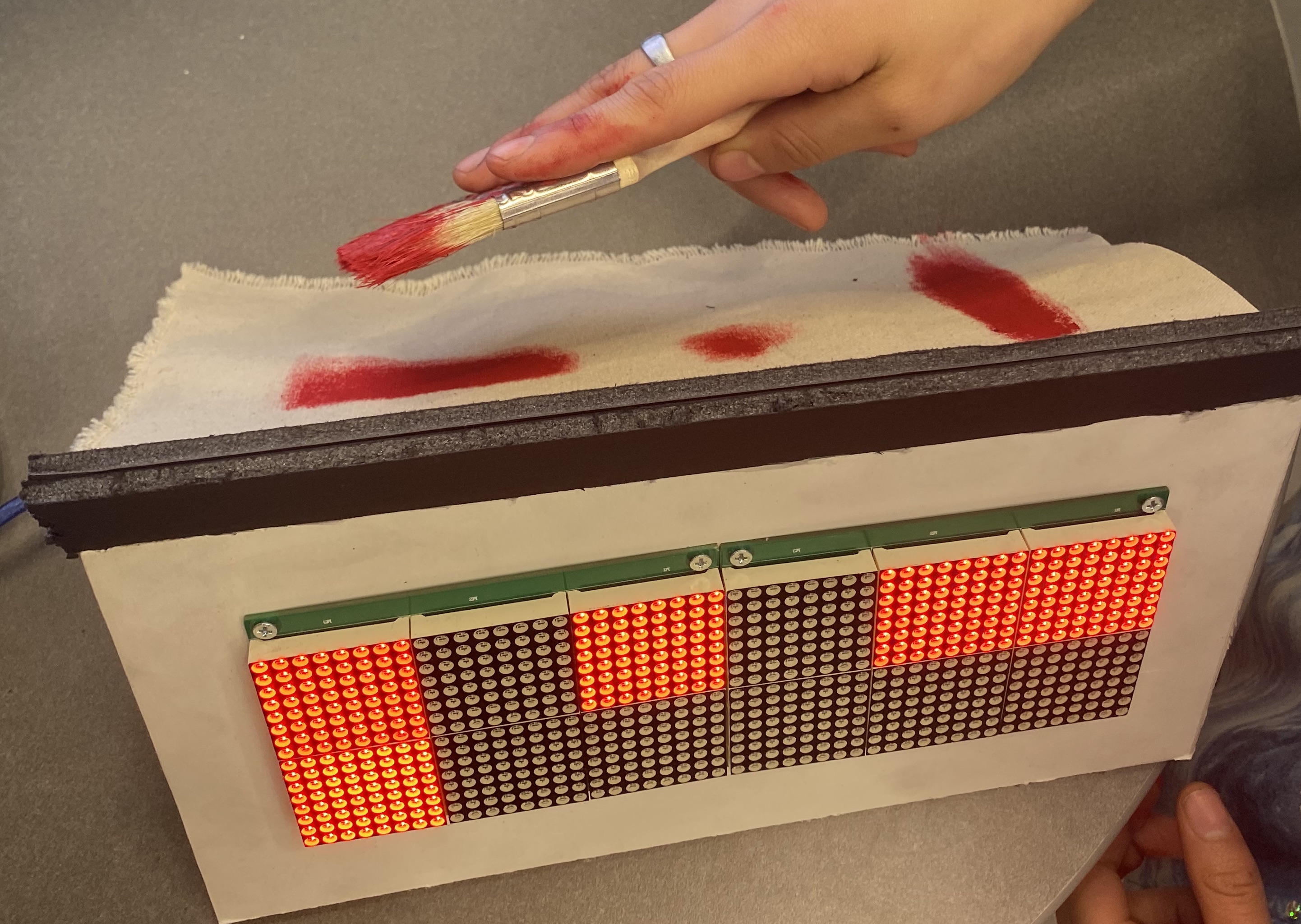
Threads
@ Wellesley HCI
Role/Team
Myself (Engineer Lead)
Yasmin Afifi (Design Lead)
Kensy Jordan (Project Manager)
Myself (Engineer Lead)
Yasmin Afifi (Design Lead)
Kensy Jordan (Project Manager)
Tools
Arduino IDE, Arduino MEGA, Adafruit LED screen, Capactive touch fabric
Arduino IDE, Arduino MEGA, Adafruit LED screen, Capactive touch fabric
Duration
4 weeks, 2022
4 weeks, 2022
Our Mission
Using speculative design framework our team explored the work of artists, brainstorming ways to transform the way they work.
How might we design a novel tangible user interface (TUI), which helps support the productivity, creativity, and well being of people who work or study in mobile environments?
What is Threads?
Threads is a tangible user technology that incorporates the traditional means of painting and transforms it into light art. We want to provide a way to learn and create simultaneously so that artists are able to expand their mediums of creation.
Methods
Speculative DesignSpeculative design, sometimes called critical design or design fiction, asks us to zoom out beyond user-centeredness and ask how our designs could impact future societies. It’s not necessarily problem solving (prototyping); it’s not trying to predict the future (forecasting), and it’s not pure criticism. It’s concerned with possibilities, not probabilities, pushing us to consider our preferences over a set of possible futures and the ways in which the objects we design help or hinder our attempts to build those futures.
Analyze
Detecting Now TendenciesIn order to participate in this digital art making, new systems require artists learn to create with new interfaces and materials while typically forgoing traditional mediums. Designing to bridge the gap between the traditional and digital mediums of art, we are concerned with the ways that artists are pushed to do their work differently in the modern age.
🎯 Create a way for artists to produce light using traditional mediums
🎯 Allow painters to explore new art media without learning any new skills
🎯 Allow painters to explore new art media without learning any new skills
Fantasize
Predicting Future ImplicationsThreads presents an exciting opportunity for artists to seamlessly create new mediums and integrate light into their artworks. The interface itself can become part of the art making process. Given the potential for engagement with audience and performance art, this is an enriching project for both its maker and for its viewers.
Concretize
Early ProcessBefore creating our interface we established significant objects, familiarizing ourselves with these technologies:
-
Arduino Uno
-
Bread board
-
Led panel
- Conductive fabric
Realize
First Iteration︎︎︎“WIP”Our design aims to completely preserve the traditional aspects of the medium of painting on canvas. The core of our system is a grid of conductive sheet squares that are mapped to pixel squares on a 16 x 24 LED matrix. Using an Arduino MEGA, we implemented our prototype using the Arduino CapactiveSensor and GFX (graphics) library. Each of our conductive squares was connected to two digital pins and our program was set to track the capacitance of the sheets. Once a square was touched, the capacitance threshold would be reached and this would translate into the corresponding LED light square illuminating.

Once this grid system was functioning, we added on replaceable canvas directly on top of the grid. When a user paints on that canvas, the grid of conductive squares detects the corresponding capacitance changes and the LED screen lights up in the same pattern that was painted.

Re-Fantasize
Future ImplementationsAs the final project of my undergraduate computer science coursework, it was gratifying to be accepted into the Chi Work symposium on Works in Progress. My team and I were given the opportunity to further fantasize how our interface could be designed at a higher fidelity.
In terms of physical developments, we would construct a small easel-like casing to display the sensor pads and LED matrices. For more complex resolution, we’d multiply the surface area of the sensor pad and add additional matrix displays. In the following figures (drawn by Maxx Aguilar) each side of the pyramids is labelled A - D to explain our components:



On side A, rather than conductive squares, we would use triangular conductive pieces to create a grid underneath the canvas. Using magnets at each corner, the triangular canvas is replaceable. On the opposite side of the pyramid (side C) an LED screen would relay the painting in real time, brightening opacity each time a conductive triangular is touched. This would mimic the effect of adding additional layers of paint to a canvas. Side B would have a hole to open the art supply storage area, similar to side D which has a hole for carrying the interface. In addition to a clear screen button, we want to add a save button so that users can save their creations and display them on the LED screen at any time.
Reflections
As the technical lead on this project, it was refreshing to work with Arduino technology again and lead my teammates through hardware/software challenges.
Beyond our WIP we are interested in exploring the scalability of Threads, and how we could make it more than just the ability to paint, but even evolve it into the ability to create performance art through traditional mediums.